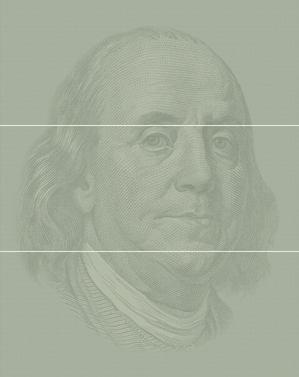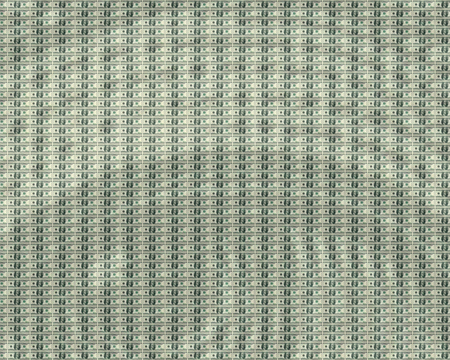University of Michigan showcasing stunning Chris Jordan artworks on sustainability
Old-school post-impressionism gets a 21st century makeover in Chris Jordan’s “Running the Numbers” on display at seven University of Michigan locations.
Jordan, a Seattle artist, has crafted a canny pointillist exhibit spread out at the College of Engineering’s Bob and Betty Beyster Building and Francois-Xavier Bagnoud Building; the Institute for the Humanities; Palmer Commons and Palmer Institute; the School of Natural Resources and Environment; the Stephen M. Ross School of Business; and, especially, the Penny W. Stamps School of Art and Design's Jean Paul Slusser Gallery.
In each of these U-M locations, Jordan’s installed artwork (or in the case of the Slusser Gallery, a number of artworks) cleverly combines themes of fine art, sociology, economics, politics and ecological sustainability.

"Ben Franklin, 2007" by Chris Jordan
courtesy of the University of Michigan Museum of Art
“Each image,” says Jordan, “portrays a specific quantity of something: two million plastic bottles (five minutes of American bottle use); 106,000 aluminum cans (thirty seconds of American can consumption) and so on.”
But what his statement doesn’t specifically address is the clever aggregated digital imagery he uses. These oversized prints feature extraordinary quantities of somethings through artful designs whose totality create a pointed reference to their gestalt.
“Finding meaning in these mass phenomena,” Jordan tells us, “can be difficult because the phenomena themselves are invisible, spread across the earth in millions of separate places. There’s no Mount Everest of waste we can make a pilgrimage to and behold the sobering aggregate of our discarded stuff, seeing and feeling it viscerally with our senses.”
His art, instead, has to do this work for us.
“We’re stuck,” he continues, “with trying to comprehend the gravity of our mass phenomena through the anaesthetizing and emotionally barren language of statistics.
“Sociologists tell us that the human mind cannot meaningfully grasp numbers higher than a few thousand; yet every day we read of mass phenomena characterized by numbers in the millions, billions, even trillions.”
Hence the vast sums in his art that have been digitally replicated in amounts beyond counting and then structured in such a manner as to give us an image far larger than their sum. It’s an audacious strategy, both handsome and appalling.
“I believe,” says Jordan, “it’s worth connecting with these issues and allowing them to matter to us personally, despite the complex mixtures of anger, fear, grief, and rage that this process can entail. Perhaps these uncomfortable feelings can become part of what connects us, serving as fuel for courageous individual and collective action as citizens of a new kind of global community.”
The 18 artworks illustrate concerns ranging from curvaceous Barbie dolls and menacing handguns to cosmological light bulbs to unconscionable stacks of prison uniforms. Yet three prime examples illustrate Jordan’s strategy.
2007’s “Ben Franklin” and 2008’s “Oil Barrels,” both at the Slusser Gallery, and 2007’s “Cans Seurat,” at the U-M School of Natural Resources and Environment, find Jordan touching on dramatically differing social, political, and ecological themes.
“Cans Seurat” says Jordan, “Depicts 106,000 aluminum cans; the number used in the U.S. every thirty seconds.” But what this work also depicts is his appropriation of Georges Seurat’s pointillism via his famed 1884-86 “The Sunday Afternoon on the Island of La Grande Jatte.”
Borrowing one of 19th century’s most distinctive artworks, Jordan has multiplied through the use of digital technology an exceedingly vivid approximation of this already scientifically oriented masterwork. As such, “Cans Seurat” not only harkens back to an earlier time when conspicuous consumption wasn’t nearly as rampant, but he also ties together the scientific and artistic impulses that run through his aesthetic.

A detail from "Ben Franklin"
The green-tinged triptych also employs Jordan’s modified pointillism—in this instance more a curvilinear aggregate of rectangular Benjamins—in the service of creating an oversized “Ben Franklin” currency portrait whose 125,000 miniature bills whip about in a frenzy across these three working surfaces.
On the other hand, abstraction is the rule of 2008’s “Oil Barrels”—a furious vortex whose darkish circularity devolves to a single central barrel of oil. This work is not only visually fastidious, it’s also a whirl of activity representing what he says is “28,000 42-gallon barrels, the amount of oil consumed in the United States every two minutes (equal to the flow of a medium-sized river).”
As Andrew J. Hoffman, director of the Ross School of Business Erb Institute for Global Sustainable Enterprise, says of Jordan’s art, “Sustainability is an issue that can be explored through all the disciplines at the university (of Michigan); business, natural sciences, engineering, the humanities, and the social sciences. By supporting the Jordan exhibit, the Erb institute is contributing to the exploration of sustainability through the arts.”
And as Don Scavia, director of the U-M’s Provost’s collaborative partnership of schools, colleges and units Graham Institute adds, “It’s wonderful to see (the U-M) come together to highlight Jordan’s innovative art, which draws attention to important global sustainability issues and proves that a picture is indeed worth a thousand words.”
As Jordan says in conclusion in his artist’s statement, “I believe it’s worth connecting with these issues and allowing them to matter to us personally, despite the complex mixtures of anger, fear, grief, and rage that this process can entail.
“Perhaps these uncomfortable feelings can become part of what connects us, serving as fuel for courageous individual and collective action as citizens of a new kind of global community. This hope continues to motivate my work.”
Chris Jordan appears at the Michigan Theater at 5:10 p.m. Nov. 15 as part of the Penny W. Stamps Speaker Series.
“Chris Jordan: Running the Numbers” will continue through Nov. 20 at the University of Michigan Penny W. Stamps School of Art and Design Jean Paul Slusser Gallery, 2000 Bonisteel Blvd, 9 a.m. to 5 p.m., Monday-Friday, and noon to 7 p.m. Saturday. The exhibit is also on display 9 a.m. to 5 p.m. Monday-Friday through Nov. 20 at the U-M College of Engineering Bob and Betty Beyster Building Atrium, 2260 Hayward St.; the U-M College of Engineering Francois-Xavier Bagnoud Building Atrium, 1329 Beal Ave.; the U-M Institute for the Humanities Osterman Common Room, 202 S. Thayer St.; the U-M Palmer Commons and Palmer Institute, 100 Washtenaw Ave.; the U-M School of Natural Resources and Environment Graduate Students Commons Area, 440 Church St.; and the U-M Stephen M. Ross School of Business Winter Atrium, 701 Tappan St. For information, call 734-368-1095.

